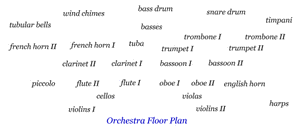Kevin
my virtual orchestra
Oct 18, 2007

I recently purchased Garritan Pocket Orchestra and I am excited about creating music for virtual orchestra. Since Pocket is like a demo version of Garritan Personal Orchestra I am augmenting it with sounds from hardware keyboards. (Pocket has complete sets of solo and ensemble strings, solo and ensemble woodwinds, and full percussion, but only four brass instruments). The Juno D has a lot of good orchestral samples, besides the many dance type synth sounds. I especially like the string articulations, the solo woodwinds, and the French Horns and Muted Trumpets. I also have an old Emu Proteus. It has a Flute, French horns, several Trumpets, a full string section, Windchimes several Pianos, and a Harp that all sound good to me. I have always liked blending sounds from several synthesizers, more than trying to play all the parts to a song on one synth.
I am learning all about writing and arranging for orchestra. Blending all the instrument sounds together in different ways to create differnt textures and tones is great fun. I have learned the basics of setting up all the midi ports and channels and bank and patch numbers to have all the instruments of the orchestra available simultaneously. I usually add the Garritan instruments one at a time because my computer isnt powerful enough to play many Garritan instruments at once. Goals I am working on include writing divisi for all the winds, and using patch changes throught the song. I had been using only one of each wind instrument, but i've started writing for two flutes, two horns and two trumpets. Now I need to add the other oboe, clarinet, bassoon, trombone, & Tuba. It can be tricky choosing whether to double an instrument, double at the octave, or play a harmony part. I also want to start using patch changes during a song. This should add to realism by making more articulations available, for instance switching from pizzacato strings to spiccato to arco. Also it will let me change the size of a section, for instance adding a piccolo and english horn player to the woodwinds in the middle of a piece.
Learning the function of the different instruments is fun too. For instance, the French Horns can be real work horses: they have great pitch range and also dynamic range and blend well with any instrument. They can even be used as part of either the brass section or the woodwind section. But they are not well suited to rapid melody lines. Flutes and oboes for instance are better at that. The brasses have the power for crashing loud passages especially when supported by the percussion. I have a lot more to learn about strings and the other instruments like harp, harpsichord, and organ and their use in an orchestra.
Setting the floor plan is another thing thats fun with a virtual orchestra. Part of the beauty of orchestral sound is the way the instrument sounds come from different locations front to back and side to side on the stage. Many different conductors have developed their own seating charts in order to place each instrument in the sound field according to the acoustics of the hall. As conductor of my own virtual orchestra i get to do this too. Front to back placement is accomplished by adding more reverb to instruments in the back, and left to right placement of course is accomplilshed with panning. I have divided my orchestra into six front to back layers: 1 violins and harps. 2 violas and cellos. 3 flutes and oboes. 4 clarinets and bassoons. 5 brasses. and 6 basses and percussion. Each section is defined from left to right as well. I try to use several tracks of each string section so i can pan the section across the stage instead of having a whole section come from a single point. Here I will try to make a visual model of my virtual orchestra floor plan.
Share
Post comment
Like